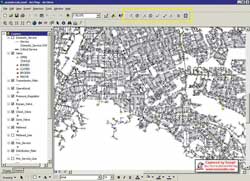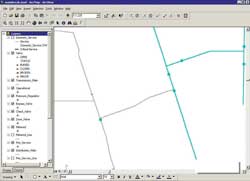ArcUser Online
The two major risks associated with using this method include shutting off water to critical services, such as hospitals or facilities serving kidney dialysis patients, and unintentionally shutting off service to a large area. The latter scenario can occur when a valve controls water flow to a large dead-end portion of a water distribution network. Usually, these situations are tough to identify. Water utilities generally rely on the best judgment of senior maintenance supervisors who know system details through many years of experience. Using a GIS water main shutdown analysis application can reduce these risks by allowing field crews and management to accurately model and display water main shutdown scenarios prior to taking action. This type of application can also benefit utilities by
Case Study—San Jose Water CompanySan Jose Water Company (SJWC) is a privately owned water utility that services the City of San Jose, California, and portions of several surrounding communities. After reviewing an application built by Esri Business Partner Weston Solutions, Inc., for Seattle Public Utilities using Esri's Workstation ArcInfo, SJWC determined that a field-based version of the shutdown application would help SJWC maintenance crews analyze main breaks. Weston built the field application in ArcView 8.1 using Visual Basic and ArcObjects running against a personal geodatabase. The resulting application provides field crews the ability to
The application was installed at SJWC's main office and on seven laptops used by field crew leaders. It has been in production since mid-year 2001. SJWC dubbed the application Main Break. Building Main BreakBuilding the SJWC network was no small feat. It is composed of 18 distinct feature layers that contain more than 40,000 distribution mains, 258,000 service lines, 288,000 valves, and assorted other equipment such as hydrants, zone valves, and transmission mains. In addition to water data, parcel centroids were used for address matching and owner/address information. SJWC's GIS data is maintained in Intergraph MGE format and was migrated into a personal geodatabase for use in the application. Once loaded into a geodatabase, a geometric network was created. Data preparation is essential when building this type of application. Tracing requires that all features in the network be connected. If parts of the network are disconnected, due to editing errors or incomplete data, a trace will return a large number of disconnected features and the analysis will be unusable. Building this application provided unforeseen benefits for SJWC because data errors were discovered and corrected during the preparation process. Although beneficial, the data preparation process was time consuming. All features and the geometric network had to be created and re-created multiple times to determine proper snapping distances and identify complex edge features. Continued on page 2 |

